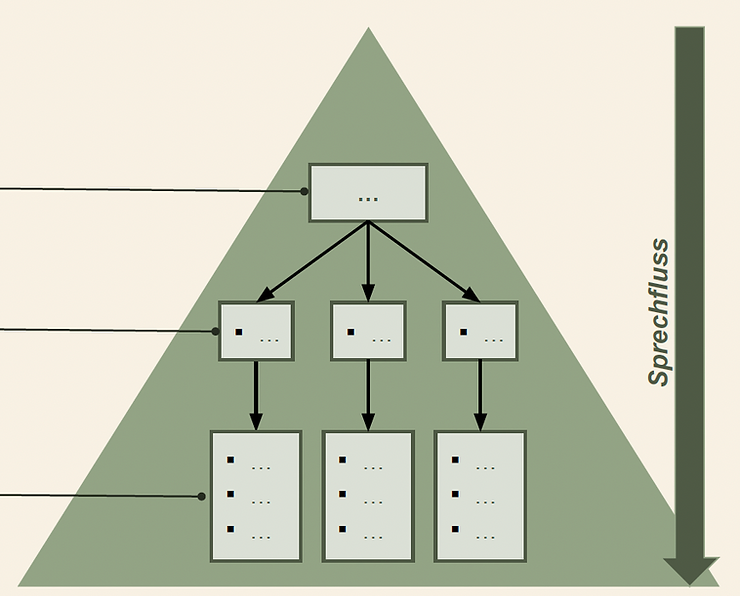The way we communicate with others and ourselves ultimately determines our quality of life. – Tony Robbins
Dear friend,
After my first consulting project last year, I had a feedback session with my project manager. Typical for newly hired consultants, I was encouraged to work on my communication skills so that my messages are conveyed more clearly.
1 year and a good amount of effort to improve my communication skills later, I better understand why communication skills are so important. No matter how profound or interesting our messages are, without proper communication skills we won’t be heard. People just won’t understand what we want to convey.
Clear communication takes practice and a conscious effort. Yet, by harnessing the knowledge of experts and their communication techniques, we can quickly progress.
In today’s blog article, I will explain to you an easy but effective communication technique I use – the Pyramid Principle – how and when to apply it, and give you practical examples so that you can make use of it, too.
Summary:
- Clear communication is a crucial skill to succeed at work
- While communication techniques are abundant, most of them are either unintuitive or ineffective
- The Pyramid Principle is an easy to implement communication technique that helps to communicate more clearl
Practical advice:
- Use the pyramid principle in your next written message, e.g., email, and follow the 3-step formula
- (1) Always start with the core message. (2) Then, follow with 2-3 supporting arguments. (3) Use examples/ data to support them
- Don’t apply the Pyramid Principle when relationship building, emotions, or the generation of information is the focus of a conversation
Clear communication
There are 3 reasons why we should all improve our communication skills:
1: Productivity. Clear communication enables the recipient of the message to grasp the content faster and better. We can save our friends and colleagues tons of time by communicating clearly.
Were you taught by a teacher in high school who failed to explain even the most basic materials? Do you have a friend who takes ages to tell something that could be said in 2 sentences? Or do work with a colleague who writes essay-long emails nobody understands?
Those are all examples of when people fail to communicate clearly.
While in private life that might not make a huge difference, in a business context, improper communication skills might derail a project or cost a promotion.
2: Persuasiveness. Clear and precise communication makes it easier to convince people of an idea.
For instance, if we want our manager to give us more time to work on a certain project, we need to give reasons for our request. If we fail to communicate those clearly, we’ll most likely fail to convince her/him.
And that’s with everything: Me who failed to convince my girlfriend to move to Berlin. Businesses that failed to convince customers to buy their product. My profs during my bachelor studies who failed to make me attend their lectures.
3: Prevention of conflicts. Clear communication plays a key role in avoiding conflicts.
I hate miscommunication. I really hate it. I’ve already had so many arguments just because I communicated something that I didn’t intend to. And why? Because I failed to communicate clearly.
Since I’ve been working on my communication skills, I’ve experienced fewer and fewer conflicts due to miscommunication. And honestly, this reason alone was worth spending the effort to work on my communication skills.
The Pyramid Principle
While communication techniques are abundant, most of them are either unintuitive, i.e. difficult to implement, or ineffective, i.e. don’t yield the desired result. So, improving our communication skills can be a real hassle.
One of the few techniques that are not only easy to implement but also very effective, I found, is the Pyramid Principle.
The Pyramid Principle suggests starting with the core message and only then listing further supporting arguments, which can be backed up with examples if necessary.
It requires working out the core of and structuring every message.
The formula to apply it: (1) Core message, (2) 2-3 arguments to support it, (3) data/ examples to support the arguments.
Here is an example: You’re asked why someone should use the Pyramid Principle and you provide him an answer using the formula.
(1) Core message: The Pyramid Principle is an easy-to-implement communication technique that helps to communicate more clearly, leading to the following 3 advantages: …
(2) Arguments: First, clear and concise communication using the Pyramid Principle makes it easier to convince people of an idea. Second, the ability to communicate effectively plays a large role in avoiding potential conflict. Third, clear communication saves time to comprehend a message, increasing the productivity of colleagues.
(3) Data/ examples: For example, in a survey of 547 business people, 81% of respondents agreed that unclear communication – written and verbal – wastes much of their time…
Using the Pyramid Principle, there are 2 types to structure messages: (1) After the core message, the supporting arguments are listed one after the other (as I illustrated in the example priorly). (2) Alternatively, an argument is immediately followed by an example or data to support it. Then the next argument is explicated.
If you want to apply the Pyramid Principle in your oral communication – and that’s really not that simple – a trick is to always announce 2-3 points in advance. For example, you’re asked what you think about the current situation revolving around Ukraine and Russia. You could say something like “I think the situation is immensely tragic, mainly because of 3 reasons: …”. Your brain is forced to find 3 reasons, and most often, your brain will find the 3 reasons that are most relevant for you.
When to (not) apply the Pyramid Principle
While the Pyramid Principle can be applied to various types of communication, it’s no universal remedy and can even lead to adverse effects. Hence, knowing when to (not) apply it is crucial.
Whenever the flow of information is the focus of a message or conversation, the Pyramid Principle can be a great means to communicate more effectively. Here are some examples:
- Presentations in a business context
- Emails and other written messages
- Answers to questions
- Voice messages
Contrarily, whenever relationship building, emotions, or the generation of information is the focus of a conversation, the Pyramid Principle shouldn’t be applied. Here are some examples:
- Get-to-know conversations
- Casual conversations
- Creative work meetings
- Advertising and storytelling


